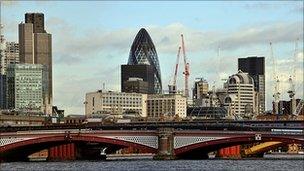Quakes 'are an issue for London'
- Published

London has little to worry about when it comes to the resistance of its modern buildings
The earthquake hazard to London has been under-appreciated, say scientists at the British Geological Survey.
They have looked at the history of tremors in the UK and have come to the conclusion that the vulnerability of its capital is far greater than many people recognise.
The South East of England is unlikely to be hit by the type of devastating event seen elsewhere in the world, but planners still need to prepare for quakes that will produce damaging shaking, the researchers argue.
They made their remarks at the British Science Festival, which is hosted this year at Aston University in Birmingham.
The biggest UK quake on record occurred out in the North Sea, off the Yorkshire coast, in 1931.
The Magnitude 6.1 event shook the eastern side of England all the way down to London, where the waxwork head of the infamous murderer Dr Crippen in Madam Tussauds was reported to have tumbled to the floor.
A quake of Magnitude 5 or bigger will occur every 100 years or so in Britain.
St Peter's Church in Broadstairs was damaged in 1580
In April 1580, a tremor centred on the Dover Strait damaged large numbers of buildings in London and killed two people.
Even though the Dover Strait is some distance from the capital, the city's clay soils have a tendency to amplify any shaking.
A similar earthquake is almost certain to happen again sometime in the future. Scientists say they can be fairly sure about that because the earthquake of 1580 was itself a repeat of a previous tremor that occurred in 1382 with almost the same epicentre, size and effects.
"In the years since 1580 the exposure of society to earthquakes has increased enormously," explained Dr Roger Musson.
"The same earthquake happening tomorrow will impact far more people than was the case in the 16th Century.
"The size of London in terms of population is about 50 times more today than it was then. So if two people were killed in London in 1580, you can imagine for yourself what sort of scaling up that could mean for a contemporary earthquake of the same size."
No-one is suggesting London's authorities instigate the kind of earthquake disaster planning seen in cities like Tokyo or San Francisco; and the UK capital's modern skyscrapers should easily handle a Magnitude 5.5 quake.
Emergency drills that practise the response to earthquakes do take place in the UK
But the researchers believe the condition of some of London's oldest buildings should be reviewed.
"If you go round the streets of London today and just look up at the roofline, you will probably see a lot of weak, old ornaments and chimneys that it is surprising didn't come down in the last gale," said Dr Musson
"Those are the things that are most likely to be damaged. It may not sound very dramatic compared to buildings collapsing, but if you are walking in the street and a chimney falls on you - that's bad news."
This year, scientists across Europe completed the Archive of Historical Earthquake Data. This is a database that details all the recorded major tremors across the continent. It is aimed at planners, politicians, insurers - or just anybody interested in earthquake risk.
"With this resource, it is possible for people to look and see what has gone before in the past and therefore understand what sort of earthquake scenarios are to be expected at sometime in the future," said Dr Musson.